“Do I really need to sift the dry ingredients in this recipe?”
How many times have we asked this question? And how many times have we said, “Forget it! I ain’t sifting!”
We wonder if this “forget it!” mentality is the best course of action when baking, so we made two chocolate loaf cakes – one with sifted dry ingredients, and the other, un-sifted. Rakhi, who is Stacey’s longtime (note: not “old”) friend, found a great recipe from the Smitten Kitchen blog for Everyday Chocolate Cake that called for sifting of dry ingredients. So Rakhi and Stacey took a Sunday afternoon to make two loaves and finally answer the question about sifting ingredients. And the answer?
Well, this wasn’t the most scientific of experiments, you see. While the ingredients and measurements were identical, one cake was baked in a metal pan, the other glass. So there’s a question about whether the pan itself made more of a difference in the end than the sifting. And since we’re strict followers of the Church of America’s Test Kitchen, we think the pan might have made the difference in the end after all.
But really, what did we find? The three taste testers all agreed: the cake that wasn’t sifted was more dense, drier and with a crunchier crust. It was moister toward the center of the cake. The un-sifted cake was baked in a dark metal pan. We all preferred the cake with the ingredients sifted and baked in a milk glass pan. It was lighter, more chocolaty and moister overall.
Here’s the Smitten Kitchen recipe so that you can test the theory in your own kitchen. Heat the oven to 325. Butter and flour a loaf pan (or spritz with butter-flour baking spray). Then in your stand mixer, cream 1 stick of softened butter on medium until smooth. Add 1 cup of brown sugar and ½ cup of granulated sugar. Beat for 3 or 4 minutes until it’s fluffy. Add an egg that has come to room temperature, 1 cup of buttermilk and 1 teaspoon of vanilla. The batter will probably look lumpy. Then sift – with a fine mesh strainer or a crank sifter – 1 ½ cups all-purpose flour, ½ teaspoon baking soda, ¼ teaspoon salt and ¾ cup cocoa powder. (What’s that, Big Spender? You want to use Dutch cocoa powder? Reduce the baking soda to ¼ teaspoon and add ½ teaspoon baking powder.) Blend everything together, but don’t overmix.
Scoop the batter into the pan and bake for at least 60 minutes on the center rack. We found that both loaves finished in 65 minutes; the cake in the metal pan finished a few minutes before the one in milk glass. You’ll know they’re done when a toothpick poked in the middle of the loaf comes out clean. Cool on a wire rack. We served it with a light dusting of powdered sugar and sliced strawberries.
Do you sift dry ingredients in a recipe? Do you think it really matters?

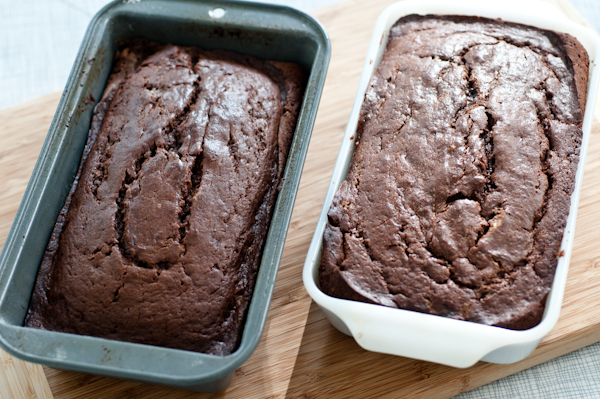
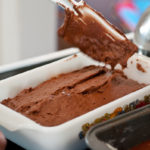
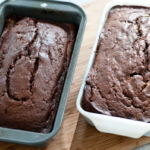
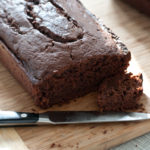
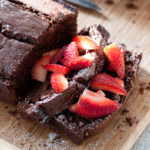
Mmm… chocolate. I share your frustration with sifting, but I almost always do it. The theory that it helps to aerate, adding lightness, and better incorporate ingredients seems to make sense to me. Of course, I have also been lazy and tried to work around with vigorous whisking or Ina Garten’s scoop, shake out, and scoop again method. I imagine, as you’ve found, sifting is still superior. Hurray for science!
light metal, dark metal, glass, and ceramic all bake differently. i think you at the very least will need to bake them in the same pan type in order to reach any real conclusion.
that being said, pretty sure i’m pretty sure the cure for ‘dry’ chocolate cake is simply a scoop of ice cream 🙂
J – Hooray for science indeed! 🙂
Natalie – Excellent solution! Both cakes were quite good, a little dryness aside. If anything, I think this convinced us to ditch our metal pans for glass.
I dO sift when the recipe calls for it..although I have never done a test of sifted versus non..so cool that you did it! Im going to make this and use the Dutch cocoa..Im an American living in The Netherlands and Dutch cocoa is sooooo cheap here! 🙂
I’ll admit that I rarely sift when a recipe calls for it. Seems to make a big mess and take a lot of extra time. But I do acknowledge that it probably makes a difference in the chemistry in the end. I agree that the material for the baking pan will make a big difference. So it’s hard to tell for sure which affected your results more, but I bet the sifting aided somewhat in the less dense texture of the preferred cake.
Shifting the dry ingredients does makes the baked goods lighter & more moist. Sometimes I forgot to shift too, and I feel the cake is more dense/heavy. if using gluten free flour, shifting it does make a big difference.
The baking time of 1 hour is rather long, no?
Shannon – We also thought 60 minutes seemed long, but when we checked in around the 45-50 minute mark, we realized it was too soon. Of course, it depends on the oven, so check the loaf before an hour is up, but don’t be surprised if it takes over an hour to bake.
I made this cake with the Dutch cocoa, since that’s what I had. I added
about two tablespoons of canola oil. The cake was really good. I topped
it with a mixture of nutella and creamcheese. Very good overall.
Nutella and cream cheese! Sounds heavenly!